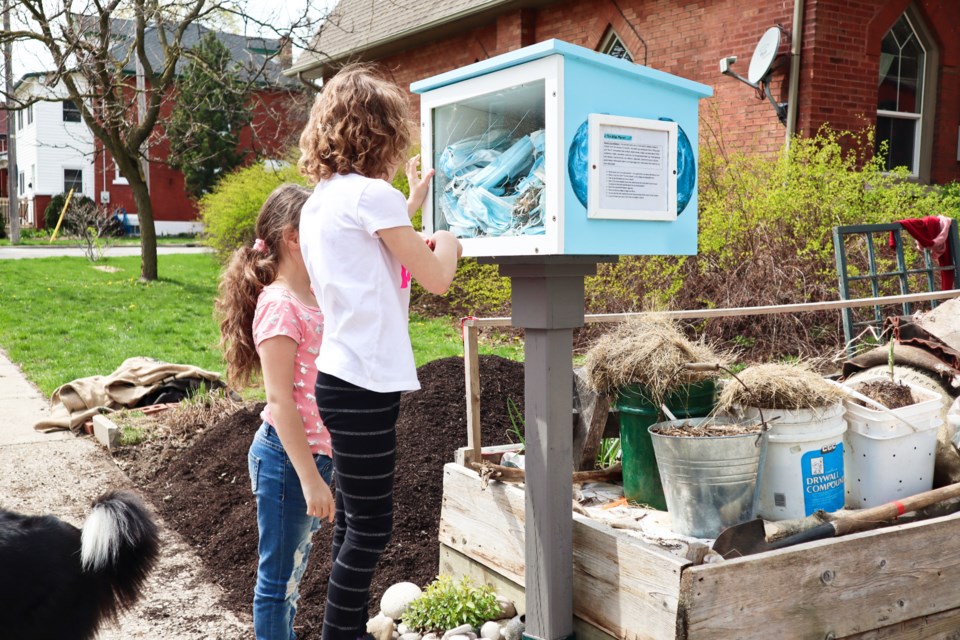Propped up on the corner or in front of yards in Guelph are little houses containing books, seeds, or in this case, little art galleries.
During the pandemic, these little art galleries have become a way for people to access art without going to a museum. They can be found in St. George’s Park, The Ward, near Exhibition Park and recently in the Two Rivers Community Garden.
Karen Houle is a University of Guelph philosophy professor and a writer who set up the little art galleries in the Two Rivers Community Garden. She is one of five artists who started little art galleries in Guelph in 2016.
Currently, Houle maintains a little art gallery and has a display called The Blue Planet. Using blue disposable face masks she found on the ground, Houle’s display uses the masks to depict waves in the ocean to spark conversations about the environment.
“Everybody and anybody can just go and look at them," she said about little art galleries, “and we would never put anything difficult or intellectual in there.
"It's a very easy way to have a small, pleasant, visual experience."
Houle recalls first learning about little art galleries in Toronto. An organization called the Open Field Collective was giving away 40 boxes to volunteers to maintain little galleries at their homes. This group reached out to four Guelph artists, including Houle, to see if they were interested.
“They would switch the shows every six weeks," said Houle, "They would just rotate them between all the galleries and it was just super cool."
A year later, Houle was working at the Guelph Centre for Urban Organic Farming when she and some other people came up with putting little art galleries in the space as a way of acknowledging the Indigenous peoples who lived on the land prior to colonization.
"We also thought the art boxes should be a part of that as well, very strongly," said Houle, "So that's why we wrote the land acknowledgements that we did. They weren't boiler plates, they weren't just something we pulled off the web, we wrote it for that place.
“Also, the cool thing is we set up the boxes in the cardinal directions, according to the colours of the medicine wheel."
In late 2020, the little art galleries were relocated to the Two Rivers Community Garden as part of relaunching the project following a change in programming at the Guelph Centre for Urban Organic Farming.
“So it's the same thing, they're set up in the cardinal directions,” said Houle, who mentions a black, white and yellow gallery have been set up at the garden, while she is still painting the red gallery.
Now that the little art galleries are almost set up in the community garden, Houle mentions looking for residents who are interested in setting up their own little exhibits.
“In this pandemic, it's especially important that people step up and take on little projects like this," she said.
Since bringing them to Guelph, Houle feels she and the other artists have helped inspire others to share a little creativity, information or resources through these boxes.
One resident who is using his little art gallery to display unusual and amusing exhibits is Lewis Melville. Located along Grange Street, Melville's 'Cabinet of Curiosities' displayed 147 exhibits from June to October last year. This past month, Melville has started adding installations again.
"The idea would be that there would be a single painting every day, and I would change it every day," said Melville, "and I would also have within it, a backdrop, sometimes just a piece of fabric, sometimes entire paintings you'll see in there, and then I would put in it a curiosity, something that would make people who would walk by, see it and go, 'Oh, what is that?'"
Some curiosities Melville has included chess pieces, a wooden snake, a stuffed kiwi, dice and more. Melville explains most of these items he finds within thrift stores or his home.
The term Cabinet of Curiosities refers to collections of notable objects owned by aristocrats. Melville originally planned to do 58 exhibits inspired by The Dance of Death, which was created by German artist Hans Holbien, inspired by the Black Plague.
"The images that I've painted have a lot of motion and dancing figures, and that sort of thing," he said, "Instead of the dance of death, I called it the dance of life, like we're going to live and this is all going to be fine."
A self-described tinker, Melville explains creating these displays is his 'zen.' Melville and and his partner, Tannis Slimmon, both enjoy seeing their neighbours and other residents interact with the displays.
"It's a distraction for people in this crazy time," said Melville, "and for me."
For Houle, she believes the little galleries add something of value to people's lives.
“They're kind of beautiful, I see people stop and look at them all the time,” said Houle, “I just think, 'Okay, that's worth it.'"
